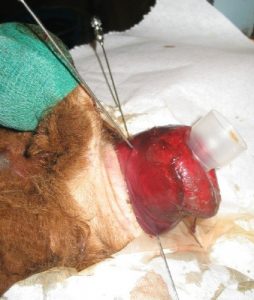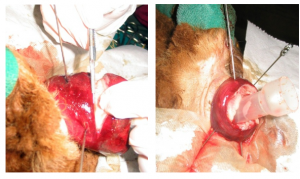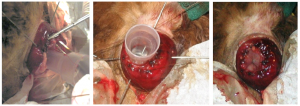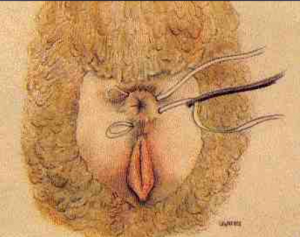FA GI Topics
How to – Rectal prolapse amputation
Indications
Rectal prolapse amputation is indicated in cases of rectal prolapse that are associated with full thickness damage or when facilities do not permit submucosal resection.
Relevant anatomy
The exposed tissue is mucosa.
Preoperative management
Food restrictions: NA
NSAIDs/analgesics: NSAIDs and an epidural are indicated.
Antibiotics: Preoperative antibiotics are indicated.
Tetanus prophylaxis is recommended for small ruminants.
Local blocks: Epidural. Lidocaine may also be infused into the rectum.
Position/preparation: Standing procedure if possible; otherwise sternal recumbency. The tail should be tied or taped away from the surgical field.
Surgery Supplies:
- Scalpel
- Needle holders
- Hemostats
- Thumb forceps
- Suture – 2-0 or 3-0 absorbable, taper needle
- Spinal needles to hold the rectum out while suturing
- Syringe case (rectal lumen diameter)
Surgical procedure
- Use older (duller) spinal needles to keep the rectum prolapsed while working. A syringe case is useful to keep the lumen identified and open.

- A full thickness incision is made distal to the spinal needles, cutting down to the syringe case.

- Suture the mucosa to the serosa in a continuous pattern. Stop part way and tie a knot to avoid a pursestring effect. [Yes, the image below shows interrupted sutures]

- Remove the spinal needles and syringe case and return to the rectum.
Postoperative care
- Use a purse string suture around the rectum to keep the tissue in place
- tie to the side and leave in place for one week
- ensure opening is large enough for pellets to be evacuated

- Maintain soft feces using a legume diet and laxatives
- Continue NSAIDS for at least 3 days
- Epidural or lidocaine infusion if straining continues
Complications
This procedure does increase the risk of rectal stricture. Dehiscence is also possible and would further increase the risk of stricture as well as perirectal abscessation.
Videos
Resources
Rectal Prolapse. Vet Clin NA FA 24 (2008) 403–408
the suture runs in and out in a circular pattern, so when pulled tight, it cinches off the center area like a purse string
sutured edges come apart; lack of healing of incision

